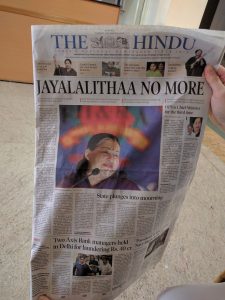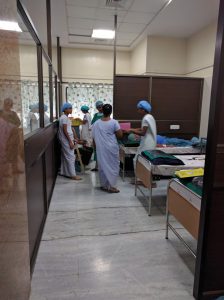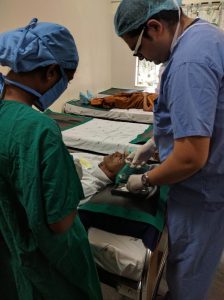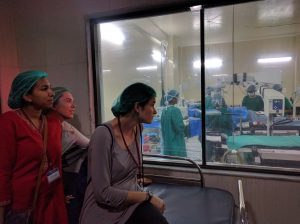With the confirmation of the chief minister’s death and the realization that our trip was drawing to a close, there was a somber atmosphere this morning.
To start, we visited the Aravind Hospital to shadow the surgeons. With several students interested in pursuing surgery, this was a unique opportunity to witness world renowned surgeons practice their art. We were guided by a first year resident and a first year fellow. The resident had just completed his first surgery by himself the same morning, and we were very grateful that both were taking time out of their busy schedules to provide us more information about the surgeries.
It was so interesting to see how the facilities at Aravind differed from American hospitals. Part of Aravind’s high volume and high quality of care comes from their compartmentalization of tasks. The pictures below show the areas that patients are guided to in preparation for their surgery. According to Dr. Zegans, the procedures done here would usually be done by the attending in the OR in the US, contributing to the surgeon’s efficiency in Aravind.
We watched the surgeons perform through these giant glass panels in the OR. The first major difference we noted was that each room had three patient beds (although only two were in use at a time when we were observing). The multiple beds allowed the nurses to prepare the next patient as the surgeon completed the surgery. As the resident and fellow explained what was happening inside, Dr. Zegans would recount to us what would be done differently in the US. We were able to observe a variety of different procedures, even though they were all cataract surgeries, owing to the diverse patient population at Aravind. Some of the what we saw included phacoemulsification, small incision removal, and even watching a surgeon adroitly manage a complication with the vitreous humor. The most prolific ophthalmologists in the US performed about 600 cataract surgeries per year whereas the Aravind ophthalmologists performed 170 cataract surgeries per day. Amazing!
Then, we attended a presentation at the LAICO Center on Aravind’s multiple vision centers. This highlighted Aravind’s strength on both ends of the care spectrum: not only were they able to deliver high quality specialized procedures as we saw this morning, but they are also able to provide primary care to areas that lacked nearby access. These differed from the outreach camps in that they were permanent facilities, but were still able to provide high quality care regardless of the patient’s ability to pay. To avoid overlap in the populations covered, Aravind placed these primary care facilities in areas that did not have access to the outreach clinics. What amazed me the most was that each primary eye care facility was able to meet eye care need within 5 years of its opening.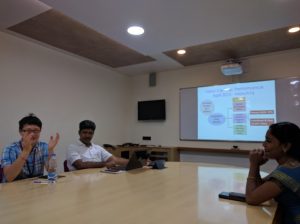
After lunch at the Inspiration House, we reflected on the trip as a group. Since we had bonded so much during the term and also on the field, we felt comfortable sharing openly the pros and cons of the course and the activities. Lastly, we had some time to wind down, reflect, and prepare for the next day before dinner at the guest house. Tonight will be the last night that we (well, most of us) will be sleeping in India for the trip. This trip has exceeded my expectations, changed my perception on research and health care, and inspired me to ceaselessly strive for excellence. I am sad that it is drawing to a close, but will cherish the memories and experiences decades later.
Signing off– tomorrow is going to be a whirlwind of a day!
-Tammy Hua, ’17


